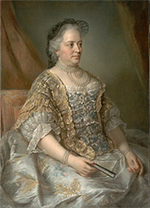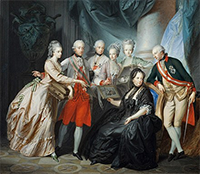The Holy Roman Emperor Francis
Francis Stephen was Holy Roman Emperor for a time in the mid-18th Century. He was the husband of Holy Roman Empress Maria Theresa, whose succession and reign were marked by controversy and war. He was born on Dec. 8, 1708, at the Ducal Palace of Nancy, in the Duchy of Lorraine. His father was Leopold, the Duke of Lorraine, and his mother was Élisabeth Charlotte d'Orléans. 
Charles VI, who became Holy Roman Emperor in 1711, wanted his daughter, Maria Theresa, to marry Francis's older brother, Leopold Clement. The intended heir apparent was only 16 in 1723 when he died of smallpox. The emperor then named Francis as his intended son-in-law and the expected husband of Maria Theresa. Francis succeeded his father as Duke of Lorraine in 1729 and then led the duchy during the five-year War of the Polish Succession. An intermediate treaty in the middle of that war gave Lorraine to the unsuccessful Polish claimant Stanislaw I, and Francis got the Grand Duchy of Tuscany in return. (He had to wait until 1737 to inherit.) In the meantime, Francis and Maria Theresa married, on Feb. 12, 1736, in Vienna. Francis and Maria Theresa became parents in 1737, with the birth of Maria Elisabeth. Two more daughters, Maria Anna (1738) and Maria Carolina (1740) followed. 
In the year that Maria Carolina was born, Maria Theresa's father, Charles VI, died. The emperor had, in 1713, issued the Pragmatic Sanction, an imperial decree that guaranteed his female children the right to succeed him on the imperial throne. By the time that Charles died, most European powers had agreed (after gaining concessions from the emperor). After he died, however, one by one renounced their agreements and vowed to contest the accession of Maria Theresa as Holy Roman Empress. The result was the War of Austrian Succesion. The war lasted eight long years, during which time Francis focused on helping his wife run the country. He had fought in Hungary against Turkey just after he was married, but he chose not to take up arms this time. A keen financial mind, he helped the empire remain solvent throughout the long conflict. During the war, in 1745, the Treaty of Füssen marked a temporary truce and also paved the way for Francis to be named Holy Roman Emperor. (He had been functioning as a king consort to his wife, the empress.) In that capacity, Francis succeeded Charles VII, the son-in-law of former Holy Roman Emperor Joseph I. Charles VII had initially supported Maria Theresa's right to inherit the throne but had changed his tune once her father died. Charles VII later became the figurehead for the anti-Habsburg forces that powered the war and, in 1742, was named King of the Romans and Holy Roman Emperor. He died in 1745. The Habsburg forces won out in the end, and Maria Theresa and Francis kept their thrones. Another conflict began in 1756, one that involved all of Europe and included fighting in far-flung locales as well. England's declaring war on France in that year started things off in the Seven Years War. In the years between the wars, Francis had kept the finances in check; during the second war, however, he lost control of the spending required to finance an increasingly losing side. The war ended in 1763, with imperial coffers nearly empty. 
Maria Theresa gave birth to six more children during the war over her succession: Joseph (1741), (a second) Maria Elisabeth (1743), Charles (1745), Maria Amalia (1746), Leopold (1747), and (the second) Maria Carolina (1748). Nowhere near done, she gave birth to five more in the years in between wars: Maria Johanna (1750), Maria Josepha (1751), Maria Carolina (1752), Ferdinand (1754), and Maria Antonia (1755). Her last child, Maximilian Francis (1756), was born during the Seven Years War. They had 16 children in all; not all of them lived into adulthood. Francis was in a carriage returning home from the opera when he died, in Innsbruck, on Aug. 18, 1765. Maria Theresa was still alive and carried on as Holy Roman Empress. Their oldest son became Holy Roman Emperor Joseph II. |
|
Social Studies for Kids
copyright 2002–2025
David White




